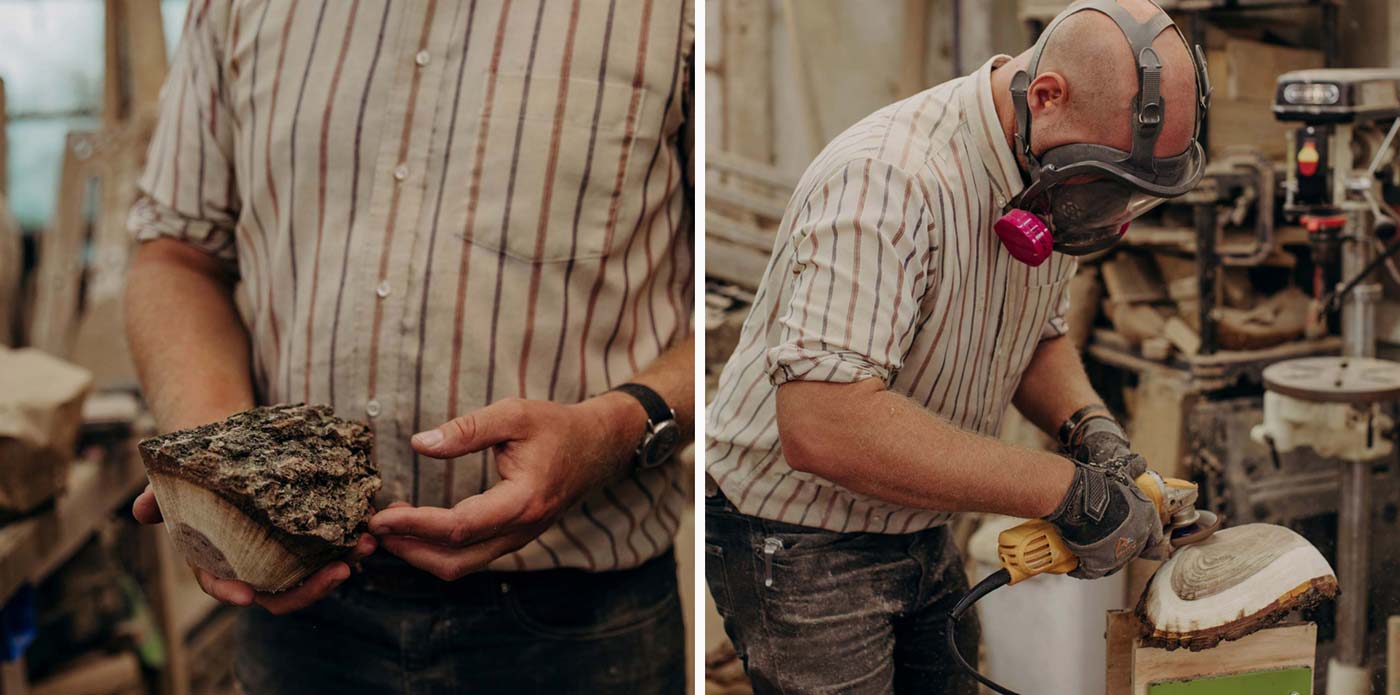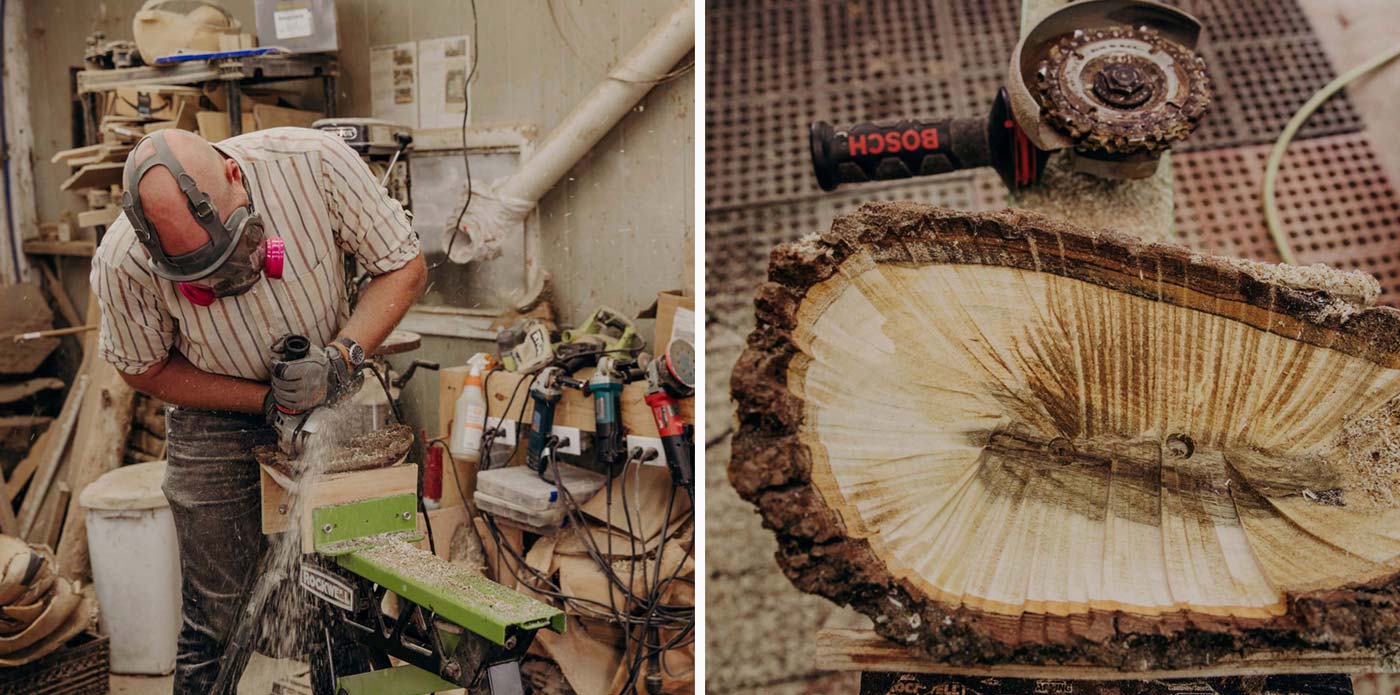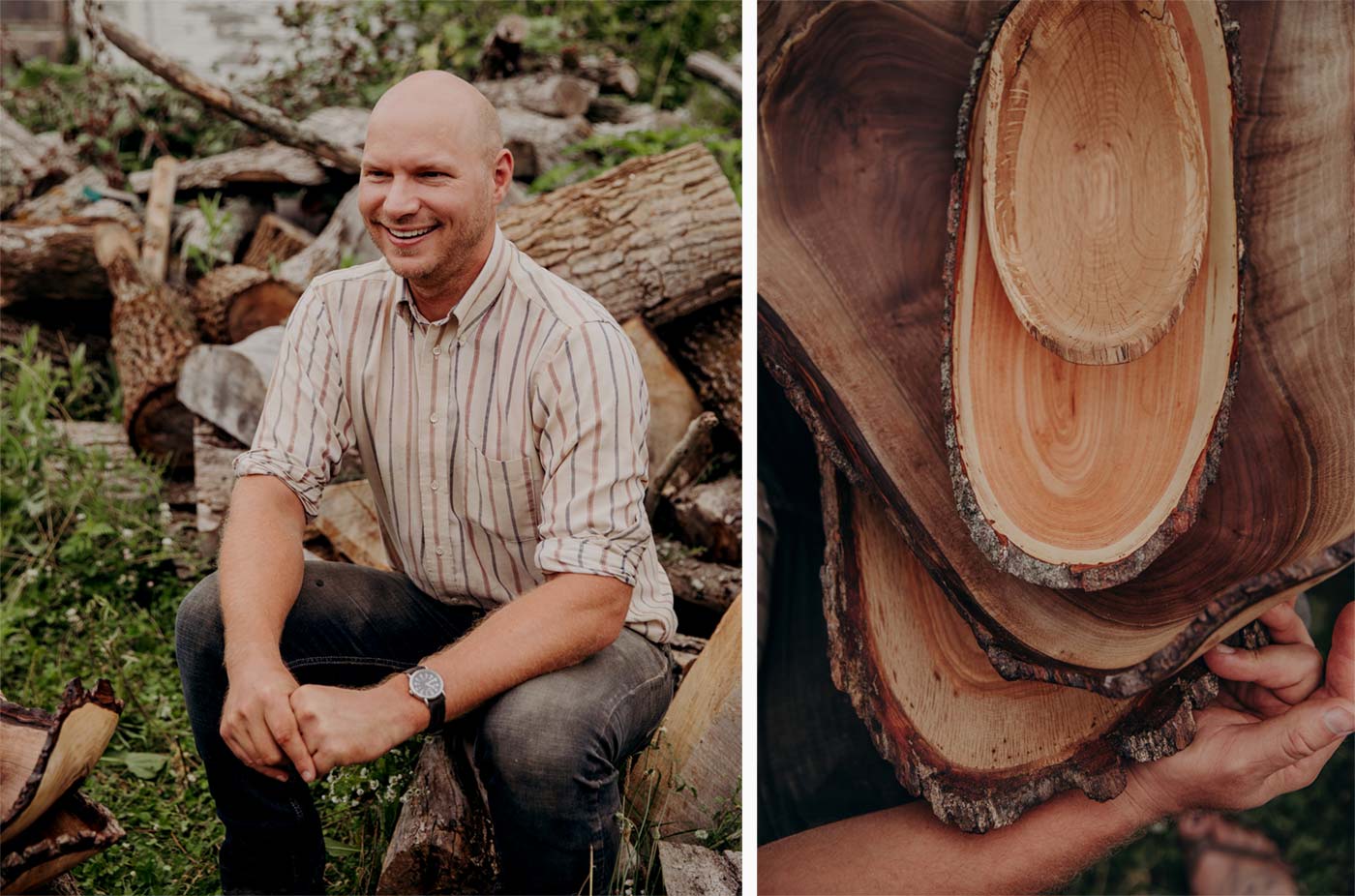Carving Out a Name for Himself
Most of us look at an oak and see a tree.
“When I see a tree,” says 41-year-old salad farmer Todd Schriver, “I see where the different bowls are and what they look like.”
Since 2018, Todd been carving wooden bowls made from “dead, dying or dangerous trees”—dangerous trees drop limbs—and selling them at the Worthington and Clintonville farmers markets.
While he continues to sell tomatoes, cucumbers and greens, his bowls have become a welcome hedge against the pandemic’s disruption in produce sales to restaurants. Photographer Rachel Joy Barehl and I visited his West Jefferson farm to see Todd in action.
FARMING AND CARVING
Todd grew up on his dad’s farm in Bluffton, Indiana, grew hay with his brother to pay for college tuition and started Wayward Seed Farm with Adam Welley in 2006. In 2010, he married wife, Heather, a physical therapist, and bought 23.5 acres in West Jefferson, selling 3.5 acres to Kate Hodges of Foraged & Sown organic produce, and dubbing the rest of the property Rock Dove Farm.
Already a hobby furniture maker, Todd was prompted to start making bowls by the availability of ash wood that resulted from the emerald ash borer infestation.
“Taking wood to a mill and milling it into boards is expensive,” he explains. “And it takes a long time to dry when it’s thick—a piece 12 inches thick might take 18 years to dry.” But a wooden bowl? “You can shape a bowl wet and then dry it. If it’s ⅜ of an inch thick, it can be dry in 45 days.”
His first try at a bowl took two days, and was “an ugly little thing.” But he persevered, and his bowls are now beautiful and sought-after and much more quickly created.
POWER CARVING
Do not picture Todd chipping away at a large piece of wood with a small knife. He is a power carver, a job that requires power tools and protective gear and generates noise and sawdust in abundance. His workshop is a no-frills standalone built of recycled windows, doors and scrap lumber, filled with the tools of his trade and a huge pile of logs.
Todd first gives us a primer on wood. “Trees are 30 to 45% water, a bundle of straws that shrink as they dry. If the ends dry faster than the middle, then the wood can crack and split.”
Some splits Todd can incorporate into the design, filling the crack with colored resin, but because the wood dries radially, bowls become longer and narrower and distort in shape. Bark—desirable for the “live edge” that customers like—can pop off.
To counter these problems, Todd carves green wood into roughly the finished shape, then packs the damp sawdust into the bowl’s interior to encourage it to dry slowly. It goes into a labeled paper grocery bag and Todd checks its moisture content periodically, finishing the bowl after it dries.
White oak is “the hardest to carve, but the most beautiful when it’s done.” Todd also favors black walnut, ash, maple, honey locust, sweet gum, burr oak, box elder, holly, birdseye maple, and cherry. But not mulberry or osage wood: “Too abrasive—they dull my tools.”

(left) The uncarved blank; (right) Carving the outside of the bowl.

(left) Carving the inside of the bowl; (right) The roughly carved bowl.

(left) Packing the bowl with sawdust; (right) A large black walnut bowl. The ripples in the grain are a result of movement between branch and tree trunk.
FROM BRANCH TO BOWL
To make a bowl, Todd first saws a log in half using a band saw, then cuts vertical slices called blanks into rough bowl shapes. For a live edge, the bark-covered side is ground away to make the inside of the bowl, leaving a bark-covered lip.
His tool of choice for power carving is the angle grinder, which is akin to a small, hand-held chainsaw. “These tools are really dangerous,” Todd says, citing several stomach-turning examples of angle grinders run amok. But he has become an expert.
“From log to unsanded blank, I can do 10 a day.” The carving takes an hour or less. A truckload of wood lasts a month.
Todd dons earplugs, as do we, then adds a respirator and gloves. He bends over the jawhorse (a steel sawhorse with a vise) where he has clamped the blank, and begins shaping the outside of the bowl with the angle grinder. We are happy to have the earplugs.
Sawdust flies like snow, settling on Todd’s arms, his jeans, his shirt and drifting gently over every item in his workshop. Although he sweeps up two garbage cans of sawdust daily, to be later composted for his vegetable garden, the shop is impossibly dusty. Even Reggie the dog sports sawdust accents on his black coat.
To carve out the inside of the bowl, Todd first marks the carving depth by drilling two holes into the bark with a radial drill press. Again, sawdust flies as he uses progressively finer-toothed grinders to grind away most of the bark and the bowl’s inside. The roughly carved end product is then packed with sawdust, bagged and shelved to dry for 45 to 60 days.
The penultimate step, sanding, “is a tremendously difficult thing to do well” mostly because it is time-consuming, requiring an hour or more of work, first with a three-inch disc sander, then by hand.
Finally, Todd finishes the bowl with mineral oil and local beeswax “from Isaac Barnes at Honeyrun Farm,” another market vendor.

(right) Todd Schriver; (left) A stack of finished bowls ready for market.
A BOWL MARKET
Today Todd sells largely from inventory, while also doing custom work—for example, a 40-inch sink basin made of white oak, then heavily epoxied to be waterproof, and a live-edge black walnut coffee table.
Todd also sells online and, surprisingly, on Twitter. “I post about four pictures showing the story of a particular bowl. I think people enjoy seeing something positive on Twitter.”
With two sons—Henry, 2, and George, 4—as well as a 14-year-old foster son, a farm employee and Reggie the dog for Todd and his wife to support, Todd is always looking for ways to improve his bottom line. Recent innovations include microwave drying for smaller bowls and a magnetic live-edge wooden knife strip.
Todd continues to refine his craft, but plans to keep growing his salad vegetables, too. “I like doing both. Four hours a day in the garden, five in the shop.” And, he adds, with three boys at home, “My most important job is being a dad.”
Find Todd’s bowls at the Rock Dove Farm stall at the Worthington and Clintonville farmers markets. Contact Todd at 614-738-1050; farmer@rockdovevegetables.com





